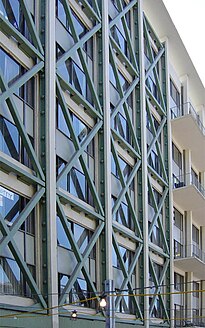This article needs additional citations for verification. (May 2010) |
Seismic retrofitting is the modification of existing structures to make them more resistant to seismic activity, ground motion, or soil failure due to earthquakes. With better understanding of seismic demand on structures and with recent experiences with large earthquakes near urban centers, the need of seismic retrofitting is well acknowledged. Prior to the introduction of modern seismic codes in the late 1960s for developed countries (US, Japan etc.) and late 1970s for many other parts of the world (Turkey, China etc.),[1] many structures were designed without adequate detailing and reinforcement for seismic protection. In view of the imminent problem, various research work has been carried out. State-of-the-art technical guidelines for seismic assessment, retrofit and rehabilitation have been published around the world – such as the ASCE-SEI 41[2] and the New Zealand Society for Earthquake Engineering (NZSEE)'s guidelines.[3] These codes must be regularly updated; the 1994 Northridge earthquake brought to light the brittleness of welded steel frames, for example.[4]
The retrofit techniques outlined here are also applicable for other natural hazards such as tropical cyclones, tornadoes, and severe winds from thunderstorms. Whilst current practice of seismic retrofitting is predominantly concerned with structural improvements to reduce the seismic hazard of using the structures, it is similarly essential to reduce the hazards and losses from non-structural elements. It is also important to keep in mind that there is no such thing as an earthquake-proof structure, although seismic performance can be greatly enhanced through proper initial design or subsequent modifications.




- ^ NZSEE Bulletin 39(2)-June 2006
- ^ ASCE-SEI 41 Archived 2013-03-03 at the Wayback Machine
- ^ NZSEE 2006 Archived 2008-11-20 at the Wayback Machine
- ^ Reitherman, Robert (2012). Earthquakes and Engineers: An International History. Reston, VA: ASCE Press. pp. 486–487. ISBN 9780784410714. Archived from the original on 2012-07-26.